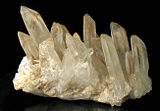Trigonal crystal system: Difference between revisions
i hope this image fits here (quartz at the top right of the page) |
oops |
||
| Line 1: | Line 1: | ||
{| class=wikitable align=right width=320 |
{| class=wikitable align=right width=320 |
||
|[[Image:Dolomite Morocco.jpg|160px]]<BR>An example of trigonal rhombohedral crystals, [[dolomite]] |
|[[Image:Dolomite Morocco.jpg|160px]]<BR>An example of trigonal rhombohedral crystals, [[dolomite]] |
||
|[[File:Kwarc, Madagaskar.jpg]]<BR>An example of trigonal crystals, [[quartz]] |
|[[File:Kwarc, Madagaskar.jpg|160px]]<BR>An example of trigonal crystals, [[quartz]] |
||
|} |
|} |
||
Revision as of 17:16, 14 August 2011
 An example of trigonal rhombohedral crystals, dolomite |
 An example of trigonal crystals, quartz |
In crystallography, the trigonal crystal system is one of the seven crystal systems, and the rhombohedral lattice system is one of the seven lattice systems. They are often confused with each other: crystals in the rhombohedral lattice system are always in the trigonal crystal system, but some crystals such as quartz are in the trigonal crystal system but not in the rhombohedral lattice system. The rhombohedral lattice system consists of the rhombohedral lattice, while the trigonal crystal system consists of the five point groups of the seven space groups with a rhombohedral lattice. There are 25 space groups whose point groups are one of the five in the trigonal crystal system, consisting of the seven space groups associated with the rhombohedral lattice system together with 18 of the 45 space groups associated with the hexagonal lattice system.
"Rhombohedral crystal system" is an ambiguous term that confuses the trigonal crystal system with the rhombohedral lattice system and may mean either of them (or even the hexagonal crystal family).
In the classification into 6 crystal families, the trigonal crystal system is combined with the hexagonal crystal system and grouped into a larger hexagonal family.[1]
Rhombohedral lattice system
A lattice system is described by three basis vectors. In the rhombohedral system, the crystal is described by vectors of equal length, no two of which are orthogonal. The rhombohedral system can be thought of as the cubic system stretched along a body diagonal. a = b = c; α = β = γ ≠ 90°. In some classification schemes, the rhombohedral lattice system is combined with the hexagonal lattice system and grouped into a larger hexagonal family.
There is only one rhombohedral Bravais lattice.
Trigonal crystal system
The trigonal crystal system is the only crystal system whose point groups have more than one lattice system associated with their space groups: the hexagonal and rhombohedral lattices both appear.
| Rhombohedral | Hexagonal |
|---|---|

|

|
The 5 point groups in this crystal system are listed below, with their international number and notation, their point groups in name and example crystals. (All these point groups are also associated with some space groups not in the rhombohedral lattice system.)[2][1][3]
| # | Point group | Examples | Space group | ||||
|---|---|---|---|---|---|---|---|
| Class | Intl | Schoenflies | Orbifold | Coxeter | |||
| 143-146 | Pyramidal rhombohedral tetartohedral |
3 | C3 | 33 | [3+] | carlinite, jarosite | P3, P31, P32, R3 |
| 147-148 | Rhombohedral rhombohedral tetartohedral |
3 | S6 | 3x | [2+,6+] | dolomite, ilmenite | P3, R3 |
| 149-155 | trapezohedral | 32 | D3 | 223 | [2,3]+ | abhurite, quartz, cinnabar | P312, P321, P3112, P3121, P3212, P3221, R32 |
| 156-161 | Ditrigonal Pyramidal rhombohedral hemimorphic |
3m | C3v | *33 | [3] | schorl, cerite, tourmaline, alunite | P3m1, P31m, P3c1, P31c, R3m, R3c |
| 162-167 | Hexagonal Scalenohedral rhombohedral holohedral |
3m | D3d | 2*3 | [2+,3] | antimony, hematite, corundum, calcite | P31m, P31c, P3m1, P3c1, R3m, R3c, |
See also
References
- ^ a b Hurlbut, Cornelius S.; Klein, Cornelis, 1985, Manual of Mineralogy, 20th ed., pp. 78–89 ISBN 0-471-80580-7
- ^ Frederick H. Pough, Roger Tory Peterson (1998). A Field Guide to Rocks and Minerals. Houghton Mifflin Harcourt. p. 62. ISBN 039591096X.
- ^ Crystallography and Minerals Arranged by Crystal Form, Webmineral
